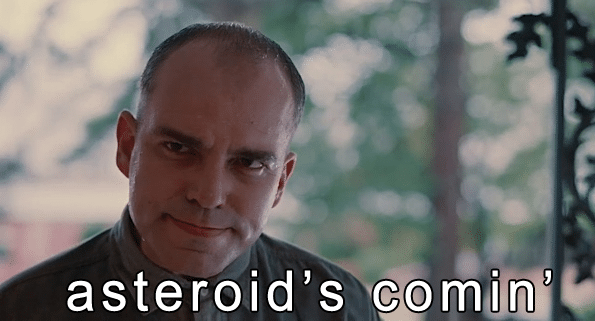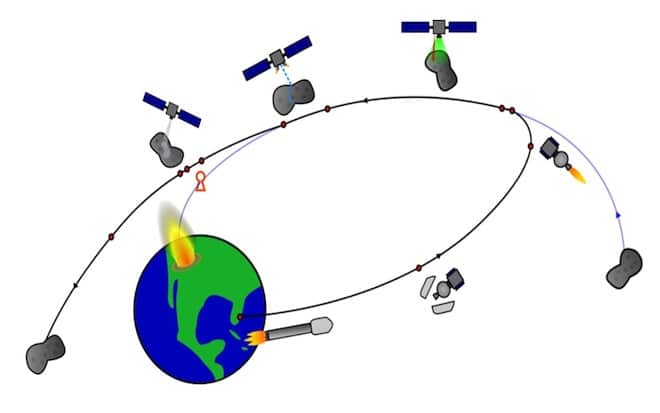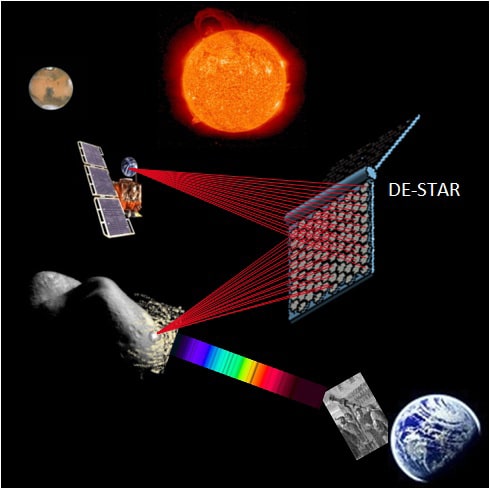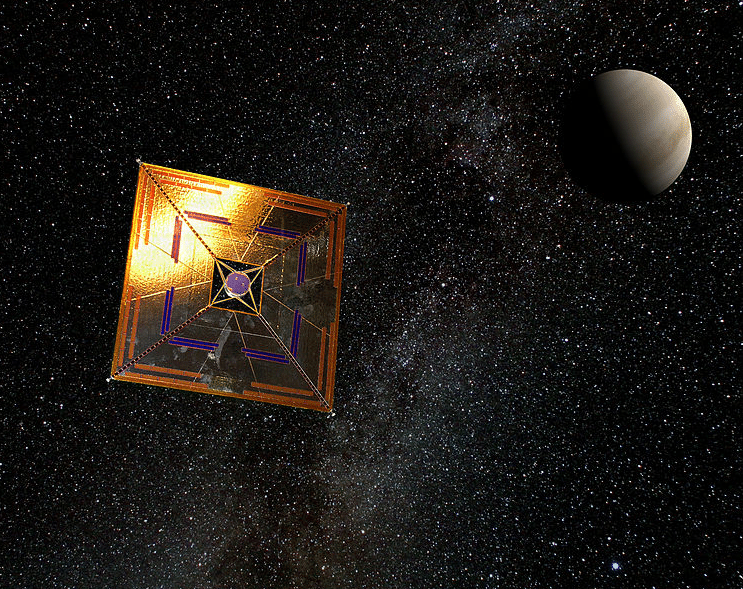
With a headline like that, one would think this would be bigger news than anything Kim Kardashian might produce, even trumping what color baby bib little cranky monkey Justin Bieber might be wearing today. But, you’d be wrong.
Here’s the fact of the matter: all over Earth right now – scientific organizations, special lobbying groups, NASA, the European Space Agency, et al – are telling lawmakers and news outlets that we need to get a collective effort going to solve the problem of hey, what happens if a global killer asteroid smashes into Earth? Can we protect ourselves? After all, apparently it only takes one medium-sized asteroid, something around a kilometer in width. You saw Armageddon, right? Billy Bob Thornton’s character makes it perfectly clear what would happen if that big rock in the movie slammed into the ocean – and this is just the movies:
“Even if the asteroid itself hits the water, it’s still hitting land. It’ll flash boil millions of gallons of sea water and slam into the ocean bedrock. Now if it’s a Pacific Ocean impact, which we think it will be, it’ll create a tidal wave 3 miles high, travel at a thousand miles an hour, covering California, and washing up in Denver. Japan’s gone, Australia’s wiped out. Half the world’s population will be incinerated by the heat blast, and the rest will freeze to death from nuclear winter.”
Now, that’s just lines from a movie. But even for a movie that’s pretty hardcore! Can you imagine it? I’ve had some bad days, but that sounds horrible. Thank goodness it’s only the movies. Are we actually supposed to entrust Billy Bob Thornton with our astrophysical safety, he was also the “french fried pertaters” guy in Slingblade?! Of COURSE we are!
Back in the real world that I live in, I ask myself exactly what might happen if a thousand thousand tons of rock slams into the bedrock of Earth. In that other movie about asteroids with Morgan Freeman (It’s called Deep Impact, and I hear that many a porno has been modeled after the title), astronauts were able to not exactly save Earth, but they were able to pulverize the asteroid enough so that only a smaller chunk of it smashed into Earth. Still, that smaller chunk made the seas rise a few hundred feet, created a big tidal wave that made the Atlantic wash up into Tennessee and killing a few hundred million Americans. But that was still just a movie! Right?!

What Do Earth’s Scientists Think?
Scientists are all over the freaking place about this very real issue right now. Some people are deeply concerned, others think that there’s such a little chance that it would ever happen:
“Right now, based on our survey, we see no national imperative for this nation to be upset or excited about impending doom.” – James L. Green, Director of NASA‘s Planetary Science Division, on Discovery
Perhaps the most daunting answer to come from the House Science Committee hearing with John Holdren was this: “An asteroid of that size, a kilometer or bigger, could plausibly end civilization… from the information we have, we don’t know of an asteroid that will threaten the population of the United States. But if it’s coming in three weeks, pray.” – White House Science Advisor John Holdren
University of California Santa Barbara physicist Philip M. Lubin thinks we should start small on smaller asteroids first – ones we know are coming: ““We need to be proactive rather than reactive in dealing with threats. Duck and cover is not an option. We can actually do something about it, and it’s credible to do something. So let’s begin along this path. Let’s start small and work our way up. There is no need to break the bank to start.”
Scientists don’t disagree that something needs to be done. What they do differ on is how it needs to be done. Some scientists feel that some sort of projectile, either nuclear or otherwise, should be thrown at the asteroid somehow. Some think that attaching some kind of “solar sail” or assisted rocket takeoff device on a grand scale would be the best bet. One scientist even suggests painting the asteroid in order to change the amount of light it reflects. Others, seriously yet still funny enough, make jokes in Senate hearings about “calling Bruce Willis,” while actual scientists theorize about possibly making a huge laser and reflector work as our asteroid goalkeeper. Lest we not forget that Bruce Willis was not only an asteroid killer in the movies, but also Died hard a whole bunch of times. Like, a TON of times. How many times can you actually die hard? Maybe he can just tell the asteroid to go f*ck itself while shooting at it. Since John Holdren pretty much summed our Earth-asteroid defense systems with “if it [an asteroid] comes in the next three weeks, pray,” then maybe some fictional help might not hurt!
A few of these ideas that scientists are kicking around still in theory format:
The long and the short of this idea is to change the amount of light that the asteroid emits in IR photos, eventually causing a miniscule “rocket thrust” in one direction. The article at Wired explains this fantastically:
The Yarkovsky effect works by changing the amount of light an asteroid gives off. As an asteroid rotates, the surface that has been heated by the sun moves away to face space and radiates infrared photons. Though massless, these photons carry away small bits of momentum from the asteroid, essentially generating a tiny rocket thrust in one direction. The effect is very slight but over time can noticeably change an asteroid’s orbit. By making an asteroid lighter or darker, and therefore changing the amount of radiation it absorbs, we could turn up or down this miniscule rocket thrust. It’s a long haul-technique, requiring years, decades, or even centuries of advanced notice to alter an asteroid’s trajectory.
Will it work? I have no idea. I don’t think we have “decades or even centuries” to wait it out, though!
DE-STAR, or Directed Energy Solar Targeting of Asteroids and exploRation
DE-STAR is basically a re-directing and re-purposing of the Sun’s energy into little laser blasts that might be able to either re-direct or completely vaporize an approaching asteroid over the course of a year. From a post at Popular Science:
Described as a “directed energy orbital defense system,” DE-STAR is designed to harness some of the power of the sun and convert it into a massive phased array of laser beams that can destroy, or evaporate, asteroids posing a potential threat to Earth. It is equally capable of changing an asteroid’s orbit —— deflecting it away from Earth, or into the Sun —— and may also prove to be a valuable tool for assessing an asteroid’s composition, enabling lucrative, rare-element mining. And it’s entirely based on current essential technology.
The DE-STAR team also claims that their system might also be able to push a spacecraft at the speed of light into the unknown. More on that in another post.
Surfing An Asteroid On Solar Sails
Solar Sails are something that have taken on validity in this race to figure out how to mitigate the asteroid threat. This would basically consist of a huge solar sail deployed in space, making good use of the ever-present solar pressure that is exerted on objects in space. From How Stuff Works:
The reflective nature of the sails is key. As photons (light particles) bounce off the reflective material, they gently push the sail along by transferring momentum to the sail. Because there are so many photons from sunlight, and because they are constantly hitting the sail, there is a constant pressure (force per unit area) exerted on the sail that produces a constant acceleration of the spacecraft. Although the force on a solar-sail spacecraft is less than a conventional chemical rocket, such as the space shuttle, the solar-sail spacecraft constantly accelerates over time and achieves a greater velocity.
Interesting. The principle of solar pressure also kind of tickles me in that special place. But again, another post for another time.
Potential Impact of Potential Impacts
Watch this – the recent asteroid that exploded over Chelyabinsk, Russia, which exploded around 40 miles above the town with the force of 300 Hiroshimas, was 55 feet across, and injured over 1500 people. This was in a sparsely populated area, so imagine the impact of an asteroid exploding over San Francisco or New York City:
Also, if you have some time (or want to skip through to where John Holdren tells the Senate Committee that if an asteroid comes to NYC in the next three weeks that we can only pray), check out John Holdren’s Senate Hearing en toto. It’s actually pretty interesting right off the bat — it might also be interesting to hear the almost comical questions and answers from our elected legislators to these scientists presenting scary information to Congress, not to mention the entire House Science Committee turning every answer of these scientists into how much it would cost and all of the interrupting that these scientists had to endure:
Thanks to:
Mother Jones
Daily Mail
Red Orbit
Space Politics
The Register
NBC’s Cosmic Log
Wikipedia on Asteroid Impact Avoidance










